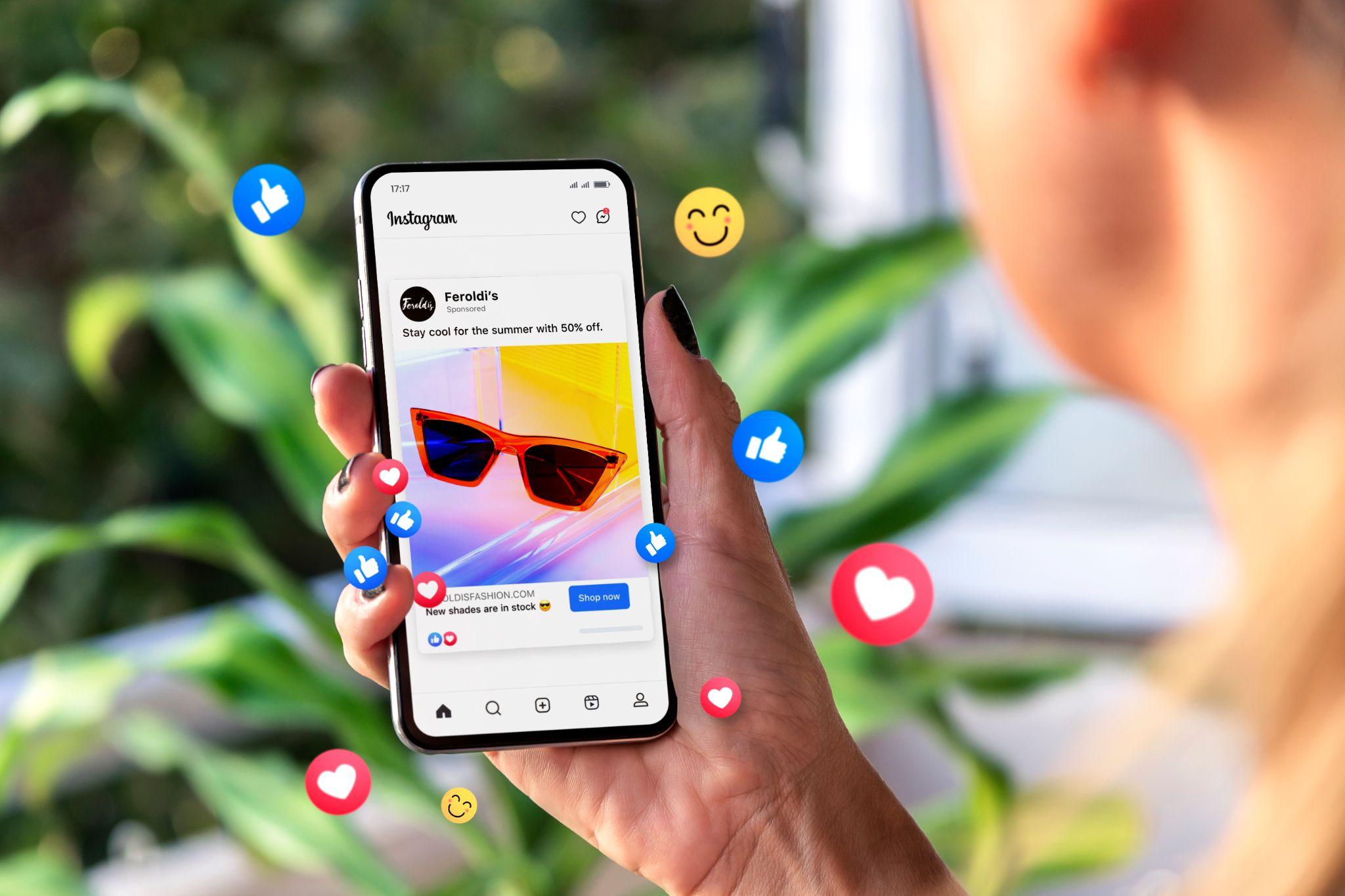
With 2 billion monthly active users, Instagram has experienced incredible growth and is paving the way for brands to connect with users and reach prospective clients.
Communication between brand and consumer has become visual, and the fastest growing channels are visually based. We get inquiries and questions from small businesses frequently asking us how they should be using Instagram for business, how to promote their business on Instagram, or just any Instagram business tips.
The biggest misconception in a small business is that if they don’t have a shiny, new product to show off, they don’t need to be on Instagram. This idea is simply not true. Instagram can be used in a number of ways, from showing off company culture to being used as a customer service tool.
Below is a guide on how to use Instagram for business.
Instagram offers small businesses an opportunity to connect with a massive audience of over 2 billion monthly active users. It’s not just about being present on the platform, but about using its powerful tools to grow your business in meaningful ways.
By creating an Instagram for a small business account, you can showcase your products or services and build a recognizable and relatable brand. Instagram’s visual nature is especially beneficial for businesses in industries like retail, food, fashion, or hospitality, where aesthetics play a crucial role in customer decision-making.
Beyond just visuals, Instagram provides valuable engagement features that can help you build a loyal community around your brand. Tools like Instagram Stories and Reels allow you to create authentic, behind-the-scenes content that fosters trust and keeps your audience coming back for more.
Instagram’s advertising options also allow you to target specific audiences, ensuring that your marketing efforts reach the right people. Whether you want to drive traffic to your website or increase brand awareness, Instagram marketing for small businesses can have a powerful impact.

If you’re wondering how to use Instagram for business, your first step is setting up an Instagram for small business account. Then you can start establishing your brand’s presence on the platform. Start by downloading the Instagram app and signing up for a business account. Choose a username that reflects your business name and is easy to remember.
Next, focus on your profile—add a clear and high-quality profile picture, typically your business logo or a recognizable image associated with your brand. Then, create a compelling bio that describes your business and what you offer. Include relevant keywords and a call to action. Don’t forget to add a link to your website.
Setting up a business Instagram properly is crucial for making a solid first impression. If you’re unsure about how to optimize your profile or create content that resonates with your audience, consider hiring a social media management agency.
An agency can help you create a professional, engaging Instagram presence and manage your account effectively. Professional agencies not only streamline the process of creating an Instagram for a business, but they also implement business Instagram best practices that boost engagement and drive traffic to your website.
A successful Instagram strategy for small businesses starts with knowing your goals and audience. First, define what you want to achieve—whether it’s increasing brand awareness, driving traffic, or boosting sales.
Once you have your goals in place, research your target audience. Who are they? What kind of content do they engage with? Knowing this will help you tailor your content to their interests.
From there, focus on creating a content calendar that ensures you’re posting consistently. Mix it up with a variety of content types, like Reels, Stories, and carousel posts to keep your feed fresh and engaging.
Next, leverage Instagram’s features, such as hashtags, geotags, and shopping tools, to reach a broader audience. Using relevant hashtags will help more people discover your content and geotags can connect you with local audiences. It’s also important to engage with your followers. Respond to comments and messages to build a sense of community.
Finally, consider hiring an expert social media marketing agency to help with your Instagram marketing for small businesses. An agency will consult you on how to use Instagram for business to your advantage. They’ll help you refine your strategy and handle daily management so you can focus on your core business operations.
When planning your content for Instagram, it’s important to use a mix of engaging and informative posts that show off both your products and your brand’s personality. Here are some examples of the kind of content small businesses can use to keep their Instagram feed fresh and engaging:
People love getting a peek behind the curtain. Behind-the-scenes content is perfect for building a personal connection with your audience. You could show how your products are made, a typical day at the office, or preparations for a new launch. By pulling back the curtain, you invite your followers into your world, making them feel more involved in your process. This type of content helps humanize your brand and demonstrates transparency, which helps build trust.
Introduce the people who make your business tick with fun and personal posts about your team members. Share their roles, what they love about working for your company, and a fun fact or two. This makes your business feel more personal and approachable, helping your audience connect with the people behind your brand. Customers are more likely to engage with a brand when they feel like they know the people who run it.
Use Instagram to showcase your products in the best light. Post high-quality photos or videos that show off the details and benefits of your products. You can also demonstrate how they’re used in real life, such as in a tutorial or user-generated content from satisfied customers. You could take it a step further by highlighting seasonal products or limited time offers to create a sense of urgency. Product highlights are a great way to convert followers into buyers by showing them exactly what they can expect from your offerings.
Sharing positive feedback from real customers builds trust and adds credibility to your business. Whether it’s a video review, a written testimonial, or a repost of user-generated content, featuring your customers’ experiences with your products can be incredibly persuasive for potential buyers. Testimonials not only provide social proof, but they also allow your current customers to feel appreciated and recognized, which can deepen their loyalty to your brand. Encourage your customers to tag your business in their posts, and then feature those reviews to enhance your credibility.

If your product requires a bit of explanation or you want to show its full potential, create how-to videos that demonstrate its use. Tutorials are a fantastic way to educate your audience while providing them with value. For example, if you sell kitchen gadgets, a quick cooking tutorial featuring your products could inspire new customers to make a purchase. Similarly, if you offer a service, short instructional videos or tips can position your brand as an expert in the field. Tutorials add value to your followers’ lives while promoting your products naturally.
Using these varied content types will help keep your Instagram feed dynamic and engaging, ensuring that your audience stays interested and feels connected to your brand.
To be successful on Instagram, you need a plan. Here are some tried-and-tested strategies:
A great profile sets the tone for your brand and helps potential followers know exactly what to expect. Use a clear profile picture that represents your brand—whether it’s a logo or a high-quality image that aligns with your business’s identity.
Next, craft a descriptive bio that captures who you are and what you offer. Include keywords related to your industry but keep it concise and engaging to make a strong first impression. And don’t forget to add a link to your website or a specific landing page so visitors can easily learn more about your business.
Your Instagram bio is your opportunity to make a lasting impact, so take time to make it stand out. Consider using emojis or line breaks to make it visually appealing and easy to read. The link in your bio is your chance to drive traffic directly to your site—use it strategically to promote a new product, an event, or a signup page.
When it comes to entering the Instagram landscape, consider your goals for the platform. Is it to create brand awareness? Drive website traffic and sales? Improve customer satisfaction through customer service?
No matter what it is, keep these goals in mind when you get to the strategy phase, as they will influence the content you create. Your goals should be specific, measurable, attainable, relevant, and timely (or S.M.A.R.T).
Before you dive into creating an Instagram strategy for your small business, look before you leap. Do your research on what is working for other businesses in your industry. You can tell how well it is performing by the engagement rate, or what is being liked, shared, and commented on by users.
When it comes to the actual content, quality over quantity. Images should be high-quality and have an instant attention-grabbing factor. Instagram is a visual platform and most users skip right over long captions. This is why your imagery needs to speak for your brand and be, what we like to call, thumb-stopping.
You’ll want to nail down content buckets, or content themes, that will keep your audience interested and help you achieve different goals. Your market research will also impact posting cadence, but don’t rely on other brands to do the work for you. In your first few months of posting, test posting at different intervals and times and track the results.
Being relatable means showing your human side and letting your audience know there’s a real person behind the account. Share content that reflects your brand’s personality but also resonates with your followers’ experiences and emotions. Show the behind-the-scenes of your business, share your struggles and successes, and talk about things that matter to you.
Respond to comments, ask questions, and share stories that invite followers to share their thoughts. Make them feel heard and valued. When people see that you’re not just a faceless brand but someone who shares their values and interests, they’re more likely to engage with your content and support your business. This connection is key to building a community that not only follows you but also advocates for your brand.
Focus on building your Instagram following in a natural, authentic way. Instead of using shortcuts like buying followers, aim for genuine engagement with people who are truly interested in what you offer. Start by identifying your target audience and interacting with their posts—commenting, liking, and following users who align with your brand. Engage with relevant hashtags and join conversations within your niche to get noticed by potential followers.
Organic growth is all about consistency and connection. As you build your presence, remember to create content that your target audience finds valuable, whether it’s educational, entertaining, or inspiring. Use Instagram Stories, Reels, and posts to keep your profile active and engaging. Encourage your followers to share your content by creating posts that spark conversations or inspire action. This approach may take time, but it ensures that your followers are genuinely interested in your content, which can lead to better engagement and long-term growth.

Posting regularly doesn’t just help with engagement—it also signals to the Instagram algorithm that your account is active, which can increase your visibility. But regular posting doesn’t mean flooding your feed. Focus on quality over quantity. Share content that reflects your brand’s message and adds value to your audience’s lives.
Create a content calendar to plan out your posts in advance, ensuring that you have a steady stream of fresh content to share. Aim for a mix of content types, such as photos, videos, Reels, and Stories, to keep your profile dynamic and engaging.
Use your insights to find the best times to post, so you can reach your followers when they’re most active. By maintaining a consistent posting schedule, you’ll build anticipation for your content and create a rhythm that your followers look forward to.
According to a study by Webdam, 60% of the top brands on Instagram use a consistent filter. This speaks to the importance of identifying your style or theme and sticking to it. In doing this, you establish a style unique to your brand that becomes recognizable to your followers.
This strategy doesn’t have to be complicated. Using a simple mobile editing app, such as VSCO, can provide the tools you need to create a consistent look across your business profile. Photographing similar color palettes with negative space helps create a cohesive feed and will be visually appealing to first-time visitors.
Hashtags are important for discovering new content and profiles to follow, as they essentially act as a search function for brands and users alike. With millions of photos uploaded daily to Instagram, you want to ensure you’re focusing on niche hashtags rather than broad ones. For example, you don’t want to hashtag #food, because hundreds of millions of posts are being uploaded constantly. Use smaller, more focused hashtags such as #homecooking or #mealprep.
Creating a hashtag for your brand is also imperative to success when using Instagram for business. This prompts followers to use it when posting about your business and it becomes easily discoverable to you. User-generated content (or UGC) is free content for you to repost if it matches the aesthetic of your feed (with permission, of course).
Facebook and Instagram have the best advertising platforms on the market. Individuals are spending more time on social media, but your advertisements should still feel authentic. If you’re not promoting posts and your goal is to help drive traffic back to your website or into a brick-and-mortar location, the focus should still not be on selling your product.
A good rule to follow is the 20/80 rule. This rule suggests that only 20 percent of your posts should be promoting products for purchase. The other 80 percent should be focused on building that community and getting engagement up.
Growing your brand’s Instagram requires a combination of strategy, engagement, and consistency. Here’s a step-by-step guide on how to use Instagram for business organically:
By following these steps, you can build a strong, engaged following that helps drive your business forward. If you need additional support, hire an expert Instagram marketing for small businesses agency to help you refine your strategy and take your account to the next level.

Socialfly can help you with every aspect of Instagram marketing, from setting up an IG account to finding influencers aligned with your brand’s messaging and identity.
Our team of social media experts can help you discover how to use Instagram for business to help you reach your goals. Check out our case studies to see how we’ve helped our clients.
Have questions on how to use Instagram for business? Email us at info@socialflyny.com and we’ll start the conversation!